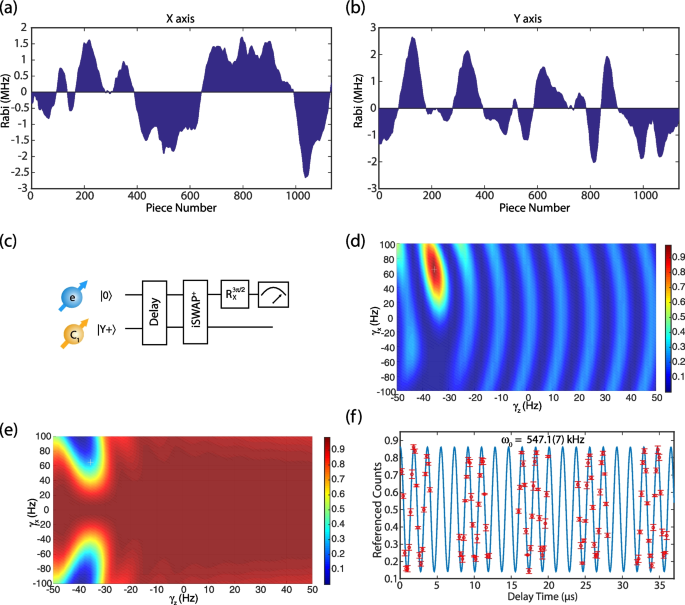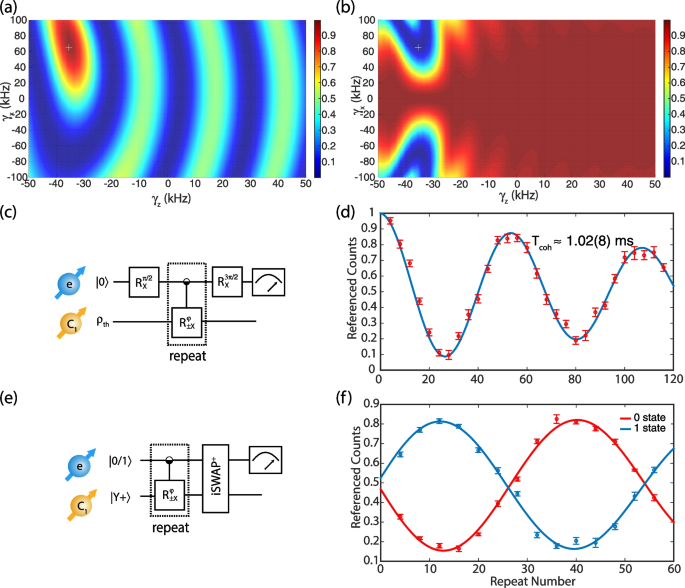-
A. Gruber, A. Dräbenstedt, C. Tietz, L. Fleury, J. Wrachtrup, C. Von Borczyskowski, Scanning confocal optical microscopy and magnetic resonance on single defect centers.
-
G. Fuchs, V. Dobrovitski, D. Toyli, F. Heremans, D. Awschalom, Gigahertz dynamics of a strongly driven single quantum spin. Science. 326(5959), 1520–1522 (2009)
-
F. Jelezko, T. Gaebel, I. Popa, M. Domhan, A. Gruber, J. Wrachtrup, Observation of coherent oscillation of a single nuclear spin and realization of a two-qubit conditional quantum gate. Phys. Rev. Lett. 93(13), 130501 (2004)
-
M.W. Doherty, N.B. Manson, P. Delaney, F. Jelezko, J. Wrachtrup, L.C. Hollenberg, The nitrogen-vacancy colour centre in diamond. Phys Rep. 528(1), 1–45 (2013)
-
L. Childress, R. Hanson, Diamond nv centers for quantum computing and quantum networks. MRS Bull. 38(2), 134–138 (2013)
-
T. Van der Sar, Z. Wang, M. Blok, H. Bernien, T. Taminiau, D. Toyli, D. Lidar, D. Awschalom, R. Hanson, V. Dobrovitski, Decoherence-protected quantum gates for a hybrid solid-state spin register. Nature. 484(7392), 82 (2012)
-
K. Xu, T. Xie, Z. Li, X. Xu, M. Wang, X. Ye, F. Kong, J. Geng, C. Duan, F. Shi et al., Experimental adiabatic quantum factorization under ambient conditions based on a solid-state single spin system. Phys. Rev. Lett. 118(13), 130504 (2017)
-
G. Waldherr, Y. Wang, S. Zaiser, M. Jamali, T. Schulte-Herbrüggen, H. Abe, T. Ohshima, J. Isoya, J. Du, P. Neumann et al., Quantum error correction in a solid-state hybrid spin register. Nature. 506(7487), 204 (2014)
-
T.H. Taminiau, J. Cramer, T. van der Sar, V.V. Dobrovitski, R. Hanson, Universal control and error correction in multi-qubit spin registers in diamond. Nat. Nanotechnol. 9(3), 171 (2014)
-
F. Kong, C. Ju, Y. Liu, C. Lei, M. Wang, X. Kong, P. Wang, P. Huang, Z. Li, F. Shi et al., Direct measurement of topological numbers with spins in diamond. Phys. Rev. Lett. 117(6), 060503 (2016)
-
S. Kolkowitz, Q.P. Unterreithmeier, S.D. Bennett, M.D. Lukin, Sensing distant nuclear spins with a single electron spin. Phys. Rev. Lett. 109(13), 137601 (2012)
-
N. Zhao, J. Honert, B. Schmid, M. Klas, J. Isoya, M. Markham, D. Twitchen, F. Jelezko, R.-B. Liu, H. Fedder et al., Sensing single remote nuclear spins. Nat. Nanotechnol. 7(10), 657 (2012)
-
T. Taminiau, J. Wagenaar, T. Van der Sar, F. Jelezko, V.V. Dobrovitski, R. Hanson, Detection and control of individual nuclear spins using a weakly coupled electron spin. Phys. Rev. Lett. 109(13), 137602 (2012)
-
G.-Q. Liu, H.C. Po, J. Du, R.-B. Liu, X.-Y. Pan, Noise-resilient quantum evolution steered by dynamical decoupling. Nat. Commun. 4, 2254 (2013)
-
C. Zu, W.-B. Wang, L. He, W.-G. Zhang, C.-Y. Dai, F. Wang, L.-M. Duan, Experimental realization of universal geometric quantum gates with solid-state spins. Nature. 514(7520), 72 (2014)
-
F. Dolde, V. Bergholm, Y. Wang, I. Jakobi, B. Naydenov, S. Pezzagna, J. Meijer, F. Jelezko, P. Neumann, T. Schulte-Herbrüggen et al., High-fidelity spin entanglement using optimal control. Nat. Commun. 5, 3371 (2014)
-
J. Zhang, A.M. Souza, F.D. Brandao, D. Suter, Protected quantum computing: interleaving gate operations with dynamical decoupling sequences. Phys. Rev. Lett. 112(5), 050502 (2014)
-
X. Rong, J. Geng, F. Shi, Y. Liu, K. Xu, W. Ma, F. Kong, Z. Jiang, Y. Wu, J. Du, Experimental fault-tolerant universal quantum gates with solid-state spins under ambient conditions. Nat. Commun. 6, 8748 (2015)
-
K. Li, Eliminating the noise from quantum computing hardware. Quantum Eng. 2(1), e28(2020)
-
J. Zhang, X.-D. Yu, G.-L. Long, Q.-K. Xue, Topological dynamical decoupling. Sci. China Phys. Mech. Astron. 62(12), 1(2019)
-
D. Lu, K. Li, J. Li, H. Katiyar, A.J. Park, G. Feng, T. Xin, H. Li, G. Long, A. Brodutch, Enhancing quantum control by bootstrapping a quantum processor of 12 qubits. NPJ Quantum Inf. 3(45), 1(2017)
-
G. Feng, G. Xu, G. Long, Experimental realization of nonadiabatic holonomic quantum computation. Phys. Rev. Lett. 110(19), 190501 (2013)
-
N. Khaneja, T. Reiss, C. Kehlet, T. Schulte-Herbrüggen, S.J. Glaser, Optimal control of coupled spin dynamics: design of nmr pulse sequences by gradient ascent algorithms. J. Magn. Reson. 172(2), 296–305 (2005)
-
K. Khodjasteh, H. Bluhm, L. Viola, Automated synthesis of dynamically corrected quantum gates. Phys. Rev. A. 86(4), 042329 (2012)
-
W. Rose, H. Haas, A.Q. Chen, N. Jeon, L.J. Lauhon, D.G. Cory, R. Budakian, High-resolution nanoscale solid-state nuclear magnetic resonance spectroscopy. Phys. Rev. X. 8(1), 011030 (2018)
-
T.H. Taminiau, J. Cramer, T. van der Sar, V.V. Dobrovitski, R. Hanson, Universal control and error correction in multi-qubit spin registers in diamond. Nat. Nanotechnol. 9(3), 171 (2014)
-
N. Bar-Gill, L.M. Pham, A. Jarmola, D. Budker, R.L. Walsworth, Solid-state electronic spin coherence time approaching one second. Nat. Commun. 4, 1743 (2013)
-
H. Bernien, B. Hensen, W. Pfaff, G. Koolstra, M. Blok, L. Robledo, T. Taminiau, M. Markham, D. Twitchen, L. Childress et al., Heralded entanglement between solid-state qubits separated by three metres. Nature. 497(7447), 86 (2013)




